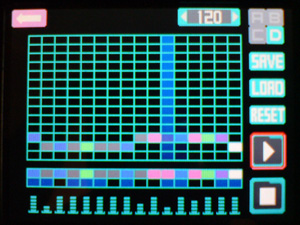The untapped musical potential of Gunpey DS
GBA musicmaker and electro wunderkind Vastik Root tries to tune up Sound Box

Hidden behind the superfluoro style and line-abusing gameplay of Q Entertainment's musical puzzler Gunpey lies a musical curiosity. Called Sound Box, it's a bonus music creation tool where you can play different pre-made loops of music (taken from the in-game soundtrack), and add your own touch of user-created magic.
It's split into three sections. The main part is the central Sound Box player, which is where you touch boxes in a grid to trigger the loops.

Then there's the Sound Sets editor (pictured below), which enables you to choose which pre-made loops you want to have at your disposal when using Sound Box. In this case, the Country-style loops are selected. You can have four sound sets available in Sound Box at any one point.

Finally there's the Patterniser, which is an editable monophonic sequencer.

Combined with the ability to use save slots, Sound Box enables you to tune and tweak your audio creations over time and then jam with Gunpey's music, which you unlock as you play through the game.
Unfortunately though, the monophonic nature of the sequencer means only one Paterniser sound can be played at a time, so no chords or beats can coincide with any notes or each other.
This severely limits the potential for serious musicmaking, meaning Sound Box is only really suitable for light experimentation and on-the-fly twiddling. Coupled with the small range of sounds on offer and constrained by four save slots, Sound Box's potential is unfairly neutered to the role of toy – something the cheap sound of Gunpey's pre-made loops only serve to compound.
With a little more time and vision though, Gunpey's Sound Box could be expanded into a musicmaking machine of merit, accessible enough for the pick-up-and-play casual gamer and deep enough for musicians on the move.
Combined with some decent audio samples, a fully-editable synthesiser would solve the problem of the limited sound palette and introduce a new level of creativity. Taking cues from similar software such as GBA sound editor Nanoloop (and traditional analogue keyboards), sounds could be created from scratch, with the touchscreen being utilised to draw unique sound waves in an entirely user-friendly way.
And as well as the potential of dual screens and using the touchscreen for quick edits, the microphone could also be used to sample new sounds. The GBA port could even be employed as an expansion slot, allowing for more power and functions. The potential for jamming with friends over Wi-Fi is obviously huge.
While all this may be a lot to ask of a bonus feature that plays second fiddle to the actual game, the potential for Sound Box's integration within Gunpey's gameplay is great, too: Gunpey's biggest crime is not enabling you to use your Sound Box creations in-game. The versatile nature of MIDI music means it could easily be achieved, and with a fully fleshed-out synth / sequencer the potential would be unlimited.
Being able to use your own music, create individual sound effects and have audio-generating gameplay changes would take Gunpey to a new level. Sound Box could almost be a level designer in disguise.
There are other options for the musical DS owner to check out. Ubisoft is due to publish Jam Sessions (aka Hiite Utaeru DS Guitar M-06 in Japan) in June, which transforms your DS into a simulated acoustic guitar, while the homebrew scene tapping its hardware's potential (with software like DSMIDIWIFI and Tobw's NitroTracker) and Bob Sabiston's Mario Paint-esque Fatbits Pocket Painter.
And if you fancy flexing your musical mouse finger and you don't have a DS or a copy of Gunpey, you can try this Japanese flash-based version of Sound Box, or see a YouTube video of it being put to some creative use in conjunction with a Kaoss Pad head.
Gunpey DS is released on the 30th March. Read Pocket Gamer's review.